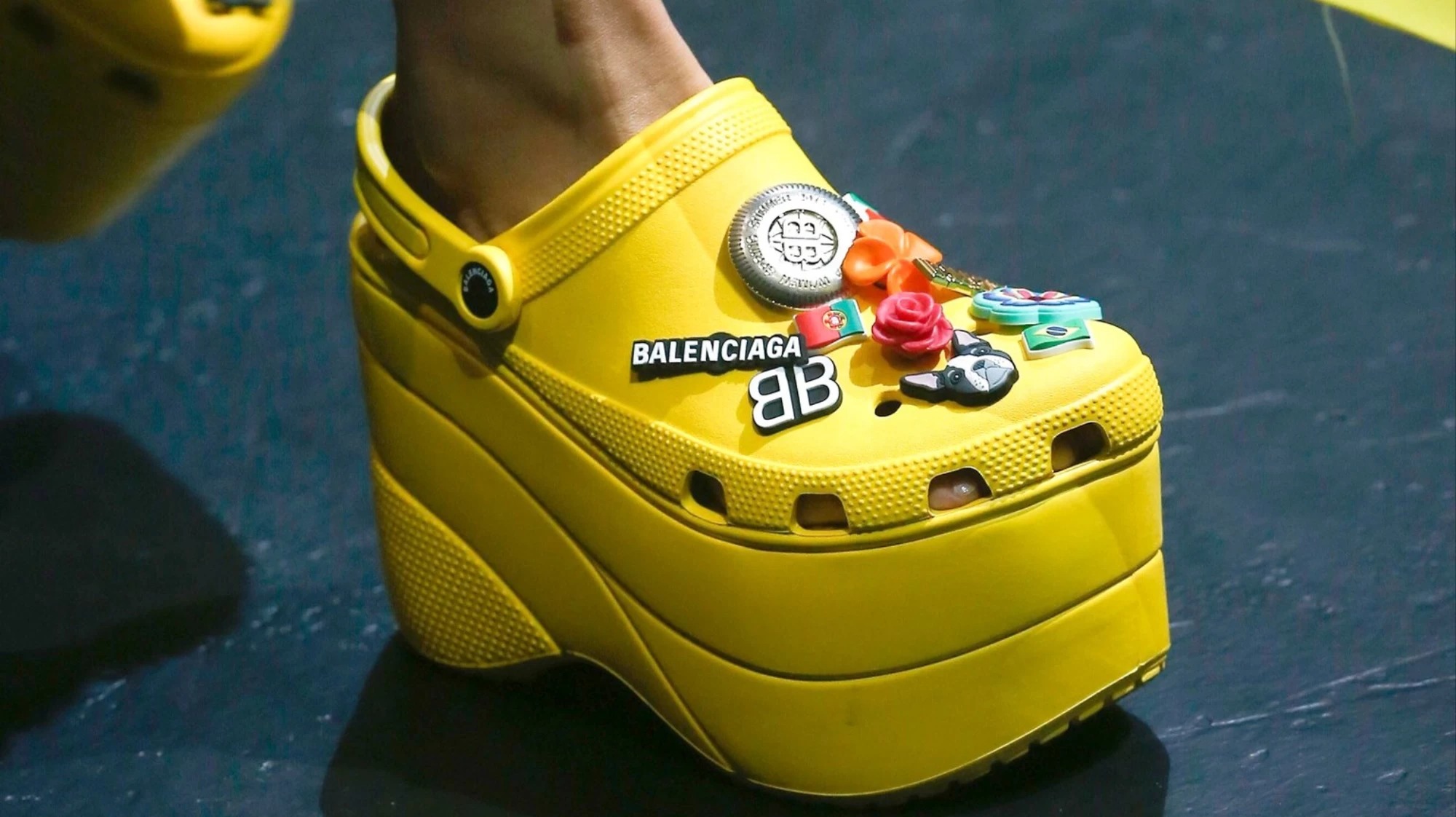It’s hard to believe that when it was originally launched in 2002, Crocs were intended just as a humble boating shoe. In the 16 years that have followed though, the perennial ugly shoe has cemented itself as a staple for chefs, toddlers, hospital staff, your dad, and now, finally, it’s been embraced by the fashion world. Our love for Crocs has grown so exponentially that it looks like, despite its obvious aesthetic issues (say what you want about them, but they’re ugly), they won’t be going anywhere for quite some time. We are, in short, obsessed with the Croc.
Collectively, in fact, we’re now so obsessed with the humble shoe that stock in the company is supposedly more lucrative than Bitcoin. New York Times reporter Jack Nicas shared a graph on Twitter that showed the price change for both Crocs and the cryptocurrency over the past year. His figures highlighted that, while it’s true bitcoin stock peaked higher than Crocs over the course of the year — it increased by a massive 300% — Crocs are a more valuable long term investment, doubling over the past 12 months. “Let’s give it up for the plastic cobbler who could!” Jack wrote.
In 2016, Crocs officially crossed over into high fashion, making their catwalk debut at Christopher Kane’s spring/summer 17 show. Part of an official collaboration, Christopher Kane’s wet-look, geode encrusted crocs immediately divided opinion. In fact the footwear proved so controversial that the designer was forced to make a statement defending them. “Crocs are great. I love them”, he said unequivocally when challenged. “I don’t care what anyone else thinks. I don’t think anyone’s got the right to say right or wrong, unless they’re God. Otherwise just shut up.”
“I knew people were going to react in that way,” he continued. “But it wasn’t about being controversial. Obviously people do like them, and that’s a different customer I want to grab. I want to include everyone and not be a snob.”
Joining in in the fight against fashion snobbery, Demna Gvasalia’s autumn/winter 17 Balenciaga collection came complete with towering, garish platform Crocs. Despite (yet again) dividing the internet and the fashion world, Crocs themselves were very into the collaboration. “Working with Balenciaga has been so much fun for our team”, Senior VP Michelle Poole said at the time. “When Balenciaga approached us we were intrigued by the opportunity to push the boundaries of our design and moulding capabilities to see what we could create together.” What they created together was, obviously, the zenith of Croc’s ugly-cool anti-aesthetic appeal.
It’s not just high fashion that’s in the midst of a Croc love affair either. A recent report by eBay found that, this April alone, there were 25,000 searches for Crocs across the site, and 15,000 sold. That equates to about 20 pairs an hour. That is, it has to be said, an awful lot of Crocs. Far from being the reserve of fashion bloggers, i.e. a piece that’s inaccessible and unwearable, Crocs are the ordinary person’s shoe. They’re equally at home on the catwalk or the sofa. They’re so beloved by the everyman, in fact, that when news broke that the company was shutting down their last manufacturing facility in Italy, social media went into overdrive in sharing their heartbreak. “SAVE OUR CROCS”, wrote one fan, while another tweeted: “I guess this is what heartbreak feels like.” The backlash was so huge that Crocs were forced to release a statement confirming that they weren’t going out of business but instead ‘streamlining’ their manufacturing processes. “Take comfort, #CrocNation. Our future remains as bright, bold and colourful as ever”, they reassured devoted fans across the world.
It wasn’t always like this. In the early years Crocs were nothing short of reviled. In 2006, four years after the company launched, a Washington Post article compared the shoes to “vermin”, branding them “hideous”. A year later Maxim listed Crocs as number six on the top ten worst things to happen to men in 2007, while in 2010, Time Magazine listed Crocs as one of the “50 worst inventions” ever. A Facebook page called ‘I don’t care how comfortable Crocs are, you look like a dumbass’ has amassed a staggering 1.2 million fans. How then, did the optics change so drastically? How did Crocs going from being reviled to being a must have fashion item?
Partly it’s down to endorsement — from both fashion houses and from celebrities. While they may have been vilified on social media, Christopher Kane and Balenciaga’s Crocs have changed the perception of the shoe from comfortable-but-ugly to expensive-but-fashionable. In the years preceding their collaborations with the divisive clog, Crocs appeared on the feet of the rich and powerful. George W. Bush, Michelle Obama and Prince George have all been spotted in them, the latter sparking a 1500% rise in searches for the shoe on Amazon, the so called “Prince George effect”. Partly the rise of the Croc is probably also down to noughties nostalgia. It’s the latest dubious trend from the 2000s to make an anti-aesthetic comeback, after Juicy Couture’s iconic velour tracksuits returned to NYFW, and Jeremy Scott reinvented the ultimate noughties cool girl shoe, the Ugg boot.
More than endorsement and nostalgia though, I would argue that we only have ourselves to blame for the world’s current love affair with Crocs. It’s our fault. We reacted so viscerally against the Croc in the early stages of its life, directed so much public vitriol towards the Croc that eventually, the pendulum had swung so far in one direction it had nowhere else to go but the whole way back. As a sort of opposite milkshake duck scenario, we hated Crocs so much that eventually, we could only grow to love them.
It was inevitable, really.

